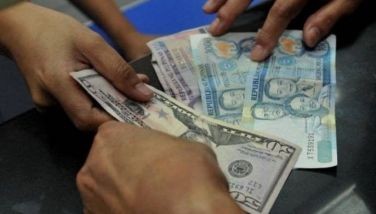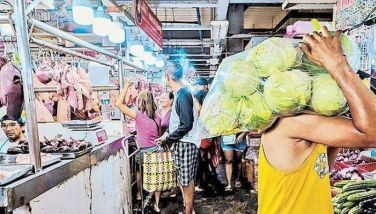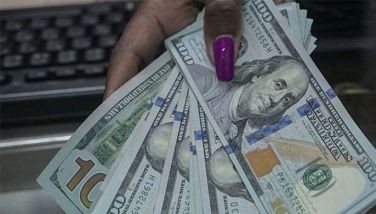Thrift banks urged to lend to SMEs
June 20, 2004 | 12:00am
Trade and Industry Secretary Cesar V. Purisima has challenged the country’s thrift banks to take a broader part in national development by increasing their lending to small and medium enterprises (SMEs).
Calling the thrift and development banks "incu-lenders" or incubator-lenders for economic growth, Purisima said that banks are primarily the SMEs’ source of funding.
"You are also intermediaries of information or info-brokers," the trade official said during a membership meeting of the Chamber of Thrift Banks (CTB), the sectoral organization of the country’s thrift, savings and development banks.
Banks are in contact with various sectors of society, and information gathered from these sectors such as suppliers, individual or commercial buyers, traders and importers, are important for the SMEs.
Likewise, technology and other sources of information as well as local or international funding sources normally pass through the branch network of the thrift banking system.
There are over 800,000 regulated entrepreneurial SMEs nationwide, accounting for 30 percent of the country’s gross domestic product (GDP) and over 95 percent of the entire business sector.
In fact, it was the SMEs that kept the economic wheel turning during the Asian financial crisis in the late 1990s. In contrast, the big corporates and foreign players either hibernated or "migrated" elsewhere.
The thrift banks have a nationwide branch network of over 1,300 located in places where SMEs thrive.
"You have the money, you have access to information, and you are all in the ground where they are located," Purisima stressed.
He said he would request the Monetary Board, the highest policy making body of the Bangko Sentral ng Pilipinas (BSP), to waive the reserve requirement imposed on banks as long as it is destined for SME lending.
He insisted that while SMEs are not risk free, they have proven to be reliable debt payers "with a non-performing loan (NPL) ratio of only eight percent, better than the system’s almost 14 percent."
BSP data indicate that lending to the SME sector dropped by P7 billion from March 2002 to December last year. Government financial institutions (GFIs) were responsible for majority of SME lending mandated by the so-called SME Unified Lending Opportunities for National Growth or Sulong.
At the forefront of the Sulong program were the Land Bank of the Philippines (LBP), the Development Bank of the Philippines (DBP), the Quedan and Rural Credit Guarantee Corp. (Quedancor), the National Livelihood Support Fund (NLSF), the Philippine Export Import Credit Agency (PhilExim), the Social Security System (SSS), and the Small Business Corp. (SB Corp.).
The Sulong program has been reportedly responsible for lending over P15 billion to the SME sector and is expected to hit P20 billion this year if government can access more funds.
The GFIs, in turn, access funds from multilateral and bilateral lending institutions including the Asian Development Bank (ADB), the World Bank, the Kreditanstalt fur Weideraufbau (KfW) of Germany, the Danish Agency for International Development (Danida), the Canadian International Development Agency (Cida), and the Japan Bank for International Cooperation (JBIC).
Calling the thrift and development banks "incu-lenders" or incubator-lenders for economic growth, Purisima said that banks are primarily the SMEs’ source of funding.
"You are also intermediaries of information or info-brokers," the trade official said during a membership meeting of the Chamber of Thrift Banks (CTB), the sectoral organization of the country’s thrift, savings and development banks.
Banks are in contact with various sectors of society, and information gathered from these sectors such as suppliers, individual or commercial buyers, traders and importers, are important for the SMEs.
Likewise, technology and other sources of information as well as local or international funding sources normally pass through the branch network of the thrift banking system.
There are over 800,000 regulated entrepreneurial SMEs nationwide, accounting for 30 percent of the country’s gross domestic product (GDP) and over 95 percent of the entire business sector.
In fact, it was the SMEs that kept the economic wheel turning during the Asian financial crisis in the late 1990s. In contrast, the big corporates and foreign players either hibernated or "migrated" elsewhere.
The thrift banks have a nationwide branch network of over 1,300 located in places where SMEs thrive.
"You have the money, you have access to information, and you are all in the ground where they are located," Purisima stressed.
He said he would request the Monetary Board, the highest policy making body of the Bangko Sentral ng Pilipinas (BSP), to waive the reserve requirement imposed on banks as long as it is destined for SME lending.
He insisted that while SMEs are not risk free, they have proven to be reliable debt payers "with a non-performing loan (NPL) ratio of only eight percent, better than the system’s almost 14 percent."
BSP data indicate that lending to the SME sector dropped by P7 billion from March 2002 to December last year. Government financial institutions (GFIs) were responsible for majority of SME lending mandated by the so-called SME Unified Lending Opportunities for National Growth or Sulong.
At the forefront of the Sulong program were the Land Bank of the Philippines (LBP), the Development Bank of the Philippines (DBP), the Quedan and Rural Credit Guarantee Corp. (Quedancor), the National Livelihood Support Fund (NLSF), the Philippine Export Import Credit Agency (PhilExim), the Social Security System (SSS), and the Small Business Corp. (SB Corp.).
The Sulong program has been reportedly responsible for lending over P15 billion to the SME sector and is expected to hit P20 billion this year if government can access more funds.
The GFIs, in turn, access funds from multilateral and bilateral lending institutions including the Asian Development Bank (ADB), the World Bank, the Kreditanstalt fur Weideraufbau (KfW) of Germany, the Danish Agency for International Development (Danida), the Canadian International Development Agency (Cida), and the Japan Bank for International Cooperation (JBIC).
BrandSpace Articles
<
>
- Latest
- Trending
Trending
Latest
Trending
Latest
Recommended






























